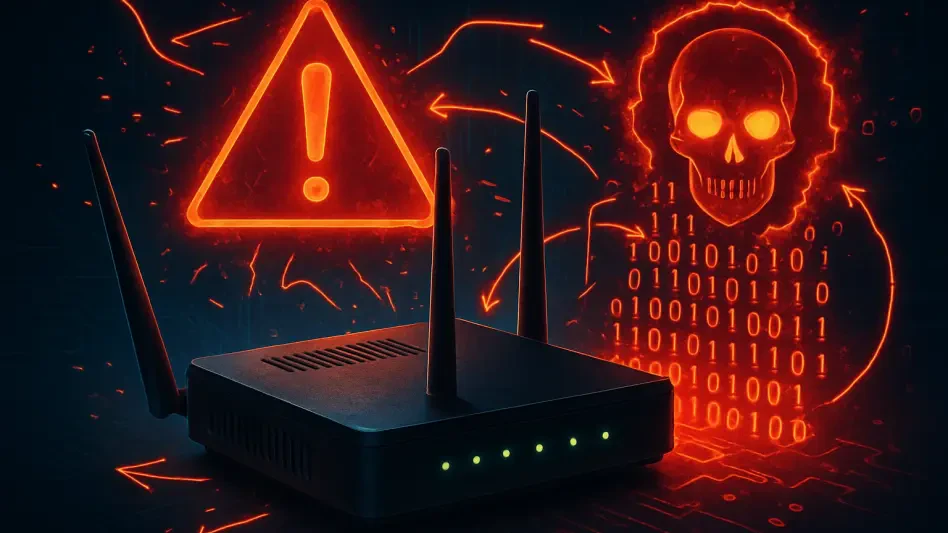What happens when the device that keeps your business connected becomes the very tool that tears it apart? In a world where industrial systems and personal networks depend on seamless internet access, a shocking discovery by cybersecurity experts has exposed critical vulnerabilities in TP-Link routers—devices trusted by countless organizations worldwide. This revelation isn’t just a technical glitch; it’s a stark reminder of how a single weak link can jeopardize entire operations, from factory floors to critical infrastructure. Dive into this urgent story of hidden dangers and the race to secure the backbone of modern connectivity.
The Silent Crisis in Connected Devices
At the heart of this issue lies a sobering truth: routers, often overlooked as mundane hardware, are prime targets for cybercriminals aiming to disrupt industrial environments and beyond. The stakes are enormous—think operational shutdowns, stolen data, or even physical harm when systems like solar inverters or water treatment plants are compromised. A recent report by a leading cybersecurity firm has zeroed in on TP-Link routers, uncovering flaws that could turn these devices into gateways for disaster. This isn’t merely a niche concern; it’s a pressing challenge for any organization relying on connected technology in an era of escalating cyber threats.
Flaws That Could Bring Systems Down
Delving into the specifics, researchers identified two severe vulnerabilities in TP-Link Omada ER605v2 and Festa VPN routers, widely used in industrial settings. Labeled as CVE-2025-7850, the first flaw allows attackers to inject malicious commands through WireGuard VPN settings, potentially without needing credentials in certain setups. The second, CVE-2025-7851, exploits leftover debug code to grant unauthorized root access, handing full control of the device to malicious actors. Beyond these, additional critical issues remain undisclosed, with patches not expected until early next year, amplifying the urgency for immediate action.
These vulnerabilities aren’t isolated incidents but part of a troubling pattern. Past fixes, such as one for CVE-2024-21827, only partially addressed problems by limiting access to debug features without removing them entirely, leaving new exploitation paths wide open. This recurring lapse in thorough remediation points to deeper systemic issues in how networking equipment is secured, raising questions about industry-wide practices and the safety of connected ecosystems.
Behind the Discovery: A Cybersecurity Battle
Experts describe the process of uncovering these flaws as a grueling endeavor, often wrestling with proprietary firmware and scarce documentation. “Securing embedded devices is like solving a puzzle with missing pieces,” noted a researcher involved in the study, highlighting the painstaking effort of rooting devices and dissecting Linux-based systems to reveal hidden risks. Their work exposed not just technical weaknesses but a broader challenge: vendors often prioritize functionality over airtight security, leaving dangerous backdoors in place for convenience or support needs.
A chilling example underscores the real-world impact—earlier this year, a simulated attack on a water treatment plant honeypot demonstrated how easily routers can become entry points for havoc. Such scenarios reveal a harsh reality: these devices, integral to critical infrastructure, are not just hardware but potential weapons in the hands of hacktivists or state-sponsored actors. The findings echo a growing concern among industry professionals about the persistent recurrence of exploitable flaws across multiple vendors.
The Broader Landscape of Risk
Zooming out, the vulnerabilities in TP-Link routers reflect a larger epidemic of security gaps in networking equipment, compounded by shared private keys and firmware design flaws that could enable widespread attacks if compromised. Regulatory measures, like firmware lockdowns, intended to bolster security, ironically delay critical updates, creating a backlog of unpatched risks. This tension between regulation and rapid response leaves organizations vulnerable, caught between compliance and the need for immediate protection in a fast-evolving threat landscape.
Industrial systems face particularly dire consequences, as routers often link internet-facing devices to sensitive controllers. A breach here doesn’t just mean data loss; it could halt production lines or endanger public safety in sectors like energy or utilities. With cybercriminals increasingly targeting these environments, the intersection of connectivity and vulnerability has become a battleground, demanding urgent attention from both vendors and users alike.
Steps to Shield Your Network Now
Amid these alarming revelations, actionable measures can help organizations fortify their defenses against such threats. Start by prioritizing firmware updates the moment they’re released—delaying patches is akin to leaving the front door unlocked. Implementing a web application firewall can filter out malicious traffic, while tightening administrative access by disabling remote interfaces or restricting them behind strictly controlled VPNs adds another layer of protection.
Continuous monitoring of network activity is also critical; spotting unusual patterns early can thwart a full-scale breach before it unfolds. For industrial setups, isolating critical systems from internet-facing devices wherever feasible minimizes exposure. These strategies, tailored to address the specific flaws identified, provide a practical roadmap for navigating risks while awaiting comprehensive vendor solutions, ensuring that businesses aren’t left defenseless in the interim.
Reflecting on a Wake-Up Call
Looking back, the exposure of critical flaws in TP-Link routers served as a jarring reminder of the fragility beneath modern connectivity. It highlighted how even the most trusted devices could harbor unseen dangers, threatening everything from industrial operations to personal security. The painstaking efforts of cybersecurity researchers to uncover these risks illuminated not just specific vulnerabilities but a pervasive challenge across the industry, urging a reevaluation of how devices are designed and protected.
Moving forward, organizations were encouraged to adopt a proactive stance—patching systems diligently, fortifying perimeters, and staying vigilant for emerging threats. Vendors, too, faced pressure to prioritize comprehensive security over quick fixes, ensuring that future updates addressed root causes rather than symptoms. This episode, though alarming, offered a chance to strengthen defenses, paving the way toward a more resilient digital landscape for all.








